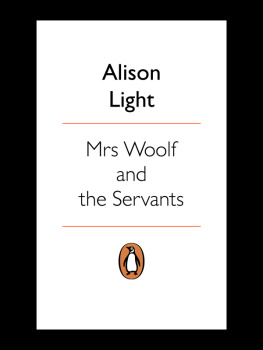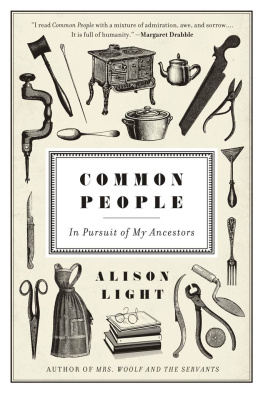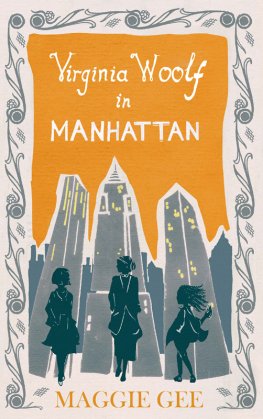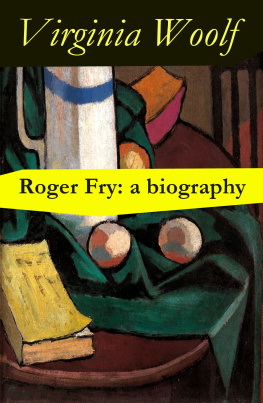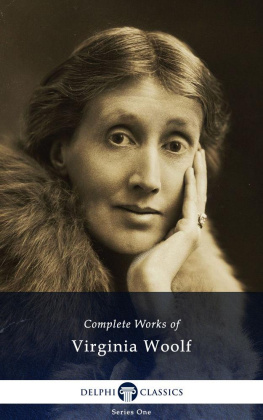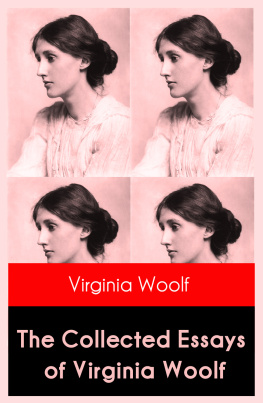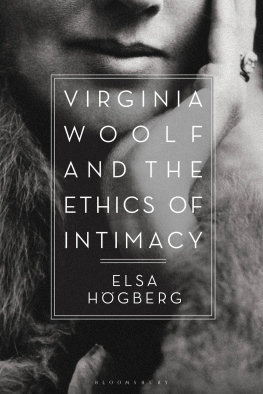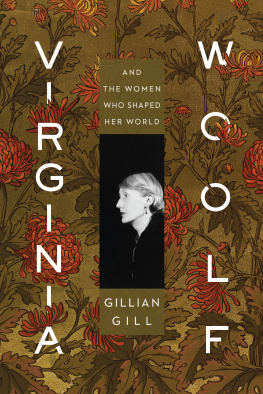Mrs Woolf and the Servants
Mrs Woolf and the Servants
ALISON LIGHT

PENGUIN

FIG TREE
FIG TREE
Published by the Penguin Group
Penguin Books Ltd, 80 Strand, London WC2R 0RL, England
Penguin Group (USA) Inc., 375 Hudson Street, New York, New York 10014, USA
Penguin Group (Canada), 90 Eglinton Avenue East, Suite 700, Toronto, Ontario, Canada M4P 2Y3
(a division of Pearson Penguin Canada Inc.)
Penguin Ireland, 25 St Stephens Green, Dublin 2, Ireland (a division of Penguin Books Ltd)
Penguin Group (Australia), 250 Camberwell Road, Camberwell, Victoria 3124, Australia
(a division of Pearson Australia Group Pty Ltd)
Penguin Books India Pvt Ltd, 11 Community Centre, Panchsheel Park, New Delhi 110 017, India
Penguin Group (NZ), 67 Apollo Drive, Rosedale, North Shore 0632, New Zealand
(a division of Pearson New Zealand Ltd)
Penguin Books (South Africa) (Pty) Ltd, 24 Sturdee Avenue, Rosebank, Johannesburg 2196, South Africa
Penguin Books Ltd, Registered Offices: 80 Strand, London WC2R 0RL, England
www.penguin.com
First published 2007
1
Copyright Alison Light, 2007
The moral right of the author has been asserted
All rights reserved
Without limiting the rights under copyright
reserved above, no part of this publication may be
reproduced, stored in or introduced into a retrieval system,
or transmitted, in any form or by any means (electronic, mechanical,
photocopying, recording or otherwise), without the prior
written permission of both the copyright owner and
the above publisher of this book
A CIP catalogue record for this book is available from the British Library
EISBN: 9780141902135
for Fran Bennett
And sit we upon the highest throne of the World,
yet sit we upon our own tail.
Michel de Montaigne, Of Experience
Contents
List of Illustrations and Picture Credits
22 Hyde Park Gate, Kensington, London
Mrs Herbert Duckworth, 1867, by Julia Margaret Cameron (albumen silver, 34 24.9cm)
Sophie, maids and Shag
Sophie Farrell and Maud Chart, 38 Brunswick Square, 1914
43 Tintern Street, Brixton, London (authors photograph)
A GIRL BEFORE AND AFTER RECLAMATION, The Graphic, 16 January 1875
Edith Sichel aged twenty-five (from New and Old)
Durbins as it was in Roger Frys day, photograph by A. C. Cooper
Flossie and Mabel Selwood, 1916
Virginia Stephen, Julian Bell and Mabel Selwood, Studland Beach, 1910
Nellie Boxall, Lottie Hope, Nelly Brittain, with Angelica Bell, 1922
Lottie Hope and Nellie Boxall
The Laughtons living room at Gordon Square, 1938
Mr. and Mrs. Charles Laughtons cook, Daily Mail, 21 February 1936
Vanessa Bell, Interior with Housemaid, 1939 (oil on canvas, 53.5 74.5cm)
Louie Everest and Trekkie Parsons
Lizzie Hornett, Nellie Boxall, Lottie Hope, with Wendy
Gravestones in Rodmell churchyard (authors photograph)
Picture Credits
Every effort has been made to trace copyright holders. The publishers will be glad to rectify in future editions any errors or omissions brought to their attention. p. 29, Royal Borough of Kensington & Chelsea Library Service; p. 41, copyright J. Paul Getty Museum, Los Angeles; copyright Harvard Theatre Collection, Houghton Library; pp. 51, 65, 129, 158, copyright Tate, London; p. 116, courtesy of Mrs E. Lukas; p. 125, courtesy of Mrs C. Phillips; pp. 188, 296, courtesy of Mrs W. Court; p. 213, courtesy of Faber, London; p. 265, Williamson Art Gallery, Birkenhead, Estate of Vanessa Bell, courtesy of Henrietta Garnett; p. 288, courtesy of Chatto & Windus, London.
Preface
If I were reading this diary, if it were a book that came my way, I think I should seize with greed on the portrait of Nelly, and make a story perhaps make the whole story revolve around that it would amuse me. Her character our efforts to get rid of her our reconciliations.
(December 1929)
When I first read Virginia Woolfs diaries, I was shocked but also fascinated by how viciously she wrote about her cook, Nellie Boxall.gossiping about her to the other servants; worst of all, Nellie seemed to relish the endless tearful scenes, which degenerated into breast-beating and mutual recriminations and left them locked in an exhausted stalemate. It was sordid, wrote Virginia, degrading and a confounded bore. But for all the dramas, Nellie never left the Woolfs and Virginia could hardly bear to part with her. After all those years of living together they were like a husband and wife who ought to divorce but cant; they were deeply, hopelessly, attached.
Taking my cue from Woolf who never did write her portrait of Nelly I wanted to tell their story. I wanted to understand what they rowed about and what was at stake in this situation which tormented them so much. What interested me was the ferocity of the feelings involved. Virginia wrote obsessively about Nellie in her diaries and letters; she felt sick after their arguments, furious, guilty, bewildered and disgusted by it all; sometimes she anxiously sought to appease Nellie, sometimes she burst out violently and defensively. The poor have no sense of humour, she decided, on one occasion. Here, it seemed to me, was a unique record, however one-sided, of the painful and defensive relationship between mistress and maid, which had rarely been written about but which echoed down through the ages and into our own day. This was a story about mutual and unequal dependence but it was also about social differences, about class feelings and attitudes which were generated and sustained by women at home and indoors rather than by men in their workplaces.
And what of Nellie? Would it be possible to learn anything about her and her side of the story? What was it like to work for Virginia and Leonard Woolf, both writers, both considered rather advanced in their views, compared to many of their day? And what did Nellie actually do for them? I wanted to know how much Nellie and Virginias story was special to them and how much it was an inevitable product of the servant relationship. This was a story of Britain in the 1920s and 30s. Were Nellie and Virginias set-tos representative of larger social changes, part of the zeitgeist as older expectations of service from the Victorian age began to crumble? I needed to expand my reach and investigate the other servants in Virginia Woolfs world if I was to understand what servant-keeping meant to her and to ladies like her. As an upper-middle-class girl Virginia Stephen had grown up in the late nineteenth century in a house with a staff of seven or so, all living in. Any facts about her nurse and nursemaid had all but disappeared, but one figure had remained steadfast in Virginias life and imagination: Sophia Farrell, always known as Sophie, who worked for Virginias parents as their cook-housekeeper, followed Virginia and her siblings when they made their own homes in the 1900s and remained in the familys employ for most of her life. Here was the prehistory of Virginias relation to Nellie.
Until I began to read about domestic service in Britain, I hadnt really grasped just how central it was to the history of women in this country. In fact, its hard to resist the conclusion that the history of service is the history of British women. Millions of women had either been servants at some point in their lives or kept servants. I was particularly interested in the period from the late nineteenth century onwards, but what historians call the feminization of service was actually in evidence from the mid-seventeenth century and by 1806 women outnumbered men in service by eight to one; by 1850 approximately 80 per cent of servants in middle-class households were women. At the beginning of the twentieth century domestic service was still the largest single female occupation. It remained so until at least 1945. Added to this were the vast numbers of other women, casual workers, such as washerwomen or chars, who eluded the census. Even though the majority of servants were temporary and saw domestic work as just a phase or a staging post, usually on the way to marriage, nonetheless the service relationship was at the heart of most womens lives in nearly all periods of British history.
Next page
